Emile Berliner - An Unheralded Genius Part I - The Early Years
Fact Paper 27-I
© Samuel Kurinsky, all rights reserved

Yet Emile Berliner is absent from America’s schoolbooks and consciousness.
- The Berliner Family
- Electronic Acoustics in the 1870's
- Emile Berliner’s Breakthrough
- The Mechanical Reproduction of Sound
- The Invention of the Gram-o-phone
- Nipper and "His Master’s Voice"
- Treason
- Notes
The name of one man, Emile Berliner, is outstanding in the industrial milieu at the end of the 19th century," unequivocally states the Museum Phonographen Grammophone in a biographical note about Berliner.1
The German museum’s concern was Berliner’s invention of the gramophone, but the statement was meant to apply to the numerous contributions Berliner had made in the fields of communication, aviation and public health as well as to entertainment. Every home business and institution in the world depends upon innovations wrought by Emile Berliner.
The roster of Berliner’s landmark innovations range from the microphone, transformer, telephone and the record-player to helicopters and airplanes. His contributions to public health won national recognition. His philanthropies were considerable. Yet only one, far from complete, biography was published on this remarkable man, a genius whose inventions had a major and permanent impact upon the burgeoning industrial society. The foreword to the book was written by none other than Herbert Hoover, then renowned as an engineer, statesman and humanitarian.
"Mr. Wile’s book," Hoover wrote in a preface to the book, "is one of those wonders of perennial fascination, the story of the life of an inventive genius..."
The work was written over seventy years ago by F. W. Wile when Berliner was alive and active in the fields of public health and philanthropy. It is entitled Emile Berliner, Maker of the Microphone, and was published by the Bobbs Merrill Company in 1926. It is now virtually unavailable!
And that is not all. Wile’s chronology ends before subsequent landmark achievements by Berliner, such as the development of the helicopter and the innovations which led to the winning of a contract with the U.S. Government over Curtiss and Boeing for a superior aircraft to theirs. No biography has since been written which includes these and other major contributions.
Bits and pieces of Berliner’s accomplishments can be gathered only from such disparate sources as court litigation archives, museums, record-collecting buffs and other enthusiasts who collect Berliner records, and from collectors of Nipper lore (Nipper being the dog listening to "His Master’s Voice" issuing from a Berliner gramophone). Some skewed information can be culled from literature about companies which appropriated and cashed in on Berliner’s seminal inventions, chief among which are the Bell Telephone company, Western Union, and companies associated with Thomas Alva Edison.
The Berliner Family
Hanover was home to the family of Emile Berliner for two centuries, dating back to 1770's, when Jokew (Jacob) Berlin and his family settled in Hannover-Neustadt. The family name indicates that it stemmed from Berlin. The name was changed to Berliner by Jacob’s son, Moses, when permanent names became required of the Hanover Jews.
The Berliners lived at first in dire poverty, for until the French occupation of the area in the Napoleonic period, Jews were prohibited from belonging to a craft or business guild. Under the new, liberalized laws the family’s fortunes changed. Moses was able to establish a successful "cut and yard goods business."
The Berliners were a pious, charitable family. Moses served the Jewish community for 42 years as president of the prestigious "Charity Association," personally involved in "relief for the poor, help for the sick, care of the dying, and ritual burying of the dead." Members of the succeeding generations of Berliners consistently and wholeheartedly participated in the life of the Hannover Jewish community.
Four years after the further liberalization of oppressive laws against Jews in 1842, the family was able to acquire citizenship. The third generation Samuel Berliner was a manufacturer of linen goods, while his brother Meyer, was in the business of dyeing and washing of silk and wool fabrics.
Samuel Berliner and his wife, nee Sarah [Sally?] Friedman, had 13 children. Eleven of their children survived, and Emile was the fourth oldest. Emile (then Emil) was born on May 20, 1851. The family was still of modest means. Several of Emile’s older brothers were called to military service. Samuel found it difficult to support his wife and their eleven children, and so, at 14 years of age, Emile was obliged to help his father support his ten siblings, and quit his schooling at the Samsonshule in Wolfenbüttel. Emile first apprenticed in a printing house, and then, at sixteen, clerked in a dry goods store. A German museum paper says he worked at a Kravattengeschaft [tie manufactury?].2
Emile’s genius for invention quickly came to the fore. After studying the extant methods of producing the fabrics he was handling, the young man constructed an improved power loom. The efficient weaving machine created by a boy in his teens was the first of a life-long series of innovations and inventions.
"Experts...expressed astonishment that an adolescent youth, unaided and without technical equipment, could have devised so practical a mechanism."3
A friend of his father, Nathan Gotthelf, visited the family from America in 1866. Herr Gotthelf had emigrated to the United States, and eventually became the proprietor of a dry-goods store in Washington. Hanover was taken over by the militaristic Prussians, and the Jews were again subjected to severe repression. Emile would soon become eligible for military conscription. In 1869, Gotthelf returned to Hanover and offered Emile a post in his store.
The family scraped together the money for his voyage to the U.S.A., and in 1870 nineteen-year-old Emile left Germany for New York on the Hammonia. Times were hard in the U.S.A. Unemployment was rampant after the panic of 1873, and Emile left Washington and returned to New York to find work. "He sold glue. He painted the backgrounds of enlarged tin-type portraits - his talent for drawing stood him in good stead for artistry. He gave German lessons."4 During this period he added the "e" to his name, "deprussianizing" the German "Emil" to the "Anglo-Saxon" "Emile." Emile worked for a time in Milwaukee and then returned to Washington.
Emile found time to take up the study of music. He took lessons in piano and violin. His musical studies may have been the root of his fascination with acoustics, a field that was then in its infancy. Avidly seeking knowledge, Emile went to the Cooper Institute in Washington, studying electricity and physics part time. During the day, every moment of his spare time was spent in the Institute’s library. At that time many would-be inventors were experimenting with the conversion of sound into electric impulses that could be transmitted over a wire.
In the bedroom of his boarding house, Emile worked far into the night on experiments with the electrical transmission of sound.
Electronic Acoustics in the 1870's
The theoretical background for electric wave transmission was established by Heinrich Hertz and Leo Graetz. Hertz was a half-Jew who brought optics, acoustics and electro-dynamics under one doctrinal discipline. A discovery by which Hertz is best known is of "Hertzian Waves," the transmission of electro-magnetic waves through space. Hertz was also the discoverer of photo-electricity, the basis for television.
Leo Graetz was the son of the famous Jewish historian, Heinrich Graetz. He was the first to investigate the dispersal of electrical waves. Thus the telegraph, telephone, radio and television are founded on the discoveries of Hertz and Graetz.
Charles Bouseouil, a Frenchman was most prominent among the early theorists who believed that electricity could be made to propel a human voice through space. His fascinating thesis came to prominence in The Didaskalia, published by-weekly in Frankfort-am-Mein Bouseouil’s account was widely publicized and available through scientific journals.
Outstanding among many who sought to translate theory into practice were Phillip Reis, a self-educated German physicist, and Antonio Meucci, born in Florence, Italy.
Reis was born in 1834 and began in his teens to experiment with electrically reproducing and transmitting sound. The first instrument young Reis built was a crude assembly designed to imitate human ear functions. A violin case was the resonator. A hollowed-out beer case was the mouthpiece. A sausage casing was stretched across the beer case to serve as a diaphragm!
Reis continued to improve his "electric ear," and demonstrated a more sophisticated model before the Physical Society of Frankfort, Germany on October 26, 1861. Reis coined the word "telephony" in that landmark demonstration. The verses of a song were transmitted from the room over a three-hundred-foot line to a hospital room. He made other demonstrations thereafter of improved versions of the telephon. "The instrument was described in over fifty publications in many countries and was well known to physicists prior to Bell’s introduction of the electric telephone as a competitor with the electric telegraph."5
"In 1863 Reis’s telephone was shown by Dr. Otto Volger, Founder and President of the Free German Institute (Freies Deutsches Hochstift), to the Emperor of Austria and to King Max of Bavaria, then on a visit to Frankfort."6
Reis was sickly and impoverished, with neither the means nor the stamina to capitalize on his device. He died on January 14, 1874 at forty years of age. On March 22, 1876, a New York Times editorial entitled "The Telephone," lauded Philip Reis as its inventor. Alexander Graham Bell was not mentioned; The writer evidently had never heard of him. Bell later claimed to have transmitted his fabled message to Watson twelve days before the editorial appeared. Bell did not originally claim to be the inventor of the device; Bell acknowledged he had known of Reis’s instrument before he applied for a patent. Bell’s application was not for a patent for a telephone, but, in fact, was merely for "an improved instrument."
Two years later, European physicists, paying no heed to Bell’s "improvement," erected a monument to "Philip Reis, the Inventor of the Telephon." The German government honored Reis for his invention of the telephon by issuing a stamp with his image.
Reis’s "electric ear" was not the only telephon with which both Bell and Berliner were familiar. Even more prominent in the United states was a caveat for a telephone patent registered with the United States Patent office by Antonio Meucci, another brilliant inventor. Meucci had first produced a "sound telegraph," a device for transforming electricity to sound as early as 1849, when Bell was only two years old! Meucci emigrated to Cuba, and then to Staten Island, New York. He was a politically active supporter of Garibaldi, who was once a guest in his modest Staten Island house. The house is now a museum.
Meucci wired his device into his home, "and formed a partnership for its development with three fellow-Italians. He called his invention a teletrofono, or electric telephone. "[His partners] advanced the sum of twenty dollars for securing a caveat, a kind of preliminary patent, which was granted [by the U.S. Patent Office] on December 28, 1871."7 He gave his instrument to a Mr. Grant to test on the wires of the American District Telegraph Company. Mr. Grant turned his papers over to the electricians of the Western Union (associated with the ADTC).
Unfortunately, Meucci became a victim of a ferryboat explosion which took the lives of a hundred people. Meucci was on the death list for a long time. Destitute and ill, Meucci allowed his caveat to lapse. The provisionary patent terminated in 1874, when it should have been renewed.
Two years later, on February 14, 1876, two persons who appear to have had access to the Reis papers at Western Union, Alexander Graham Bell and Elisha Gray, applied for patents for a telephone on the same day. Gray’s drawing was a more accurate rendition of Meucci’s invention, but Bell’s application for a patent for "an improved instrument" beat Gray’s by two hours!
Meucci sued. Bell was wealthy, and dragged the case on until 1887. Despite a parade of witnesses for Meucci, and of Meucci’s registered caveat, Judge William Watson decided in favor of Bell. The trial record leaves little doubt that the Bell company, grown rich and powerful by that time, exercised pressure on, or actually bribed the judge to rule in its favor. "[Wallace’s decision] is unquestionably one of the most glaring miscarriages in the annals of American Justice."8
Meucci wrote to Garibaldi’s daughter on October 1, 1887: "...the telephone which I invented and which I first made known and which, as you know, was stolen from me."
Meucci was not the only one to sue Bell. Elisha Gray and Western Union sued and lost. Emile Berliner, who transformed the primitive form of the telephone into a practical communications instrument, had stronger grounds for a case against the usurpers of his inventions. Berliner did win his case in court.
The device that Reis and Meucci had independently invented and the crude imitation that Bell had patented could do little more than communicate from one room to another. The sound diminished rapidly in strength and the distance over which the transmission could remain audible was extremely limited. It was little more than an electric version of the children’s toy consisting of two empty cans connected by a taught string, more of a novelty than a practical means of communication.
Nonetheless, Bell, exercising his propensity for publicity, exhibited his curious communicator at the exposition of the centennial of the American Revolution in Philadelphia.
Emile Berliner’s Breakthrough
During this same period Emile Berliner had advanced his scientific knowledge to such an extent that he was given a position as assistant to Dr. Constantine Fahlberg in his prestigious chemical laboratory. The stimulating scientific environment suited Berliner perfectly. The laboratory is famous for developing the process of manufacturing saccharin out of coal tar. When not at work, or in the Cooper Institute’s library, Berliner continued to carry on his experiments in his boarding house on Columbia Street
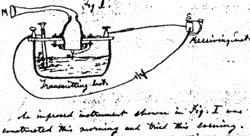
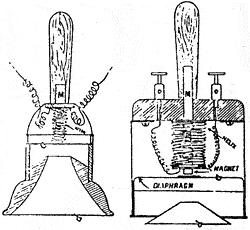
RIGHT: 1867. Meucci’s improved telephone as registered in his caveat.

"Berliner was living in a room on the third floor of a typical middle-class Washington brick dwelling of the era... Berliner’s quarters soon came to look and smell like an electrical laboratory. He filled the place with wires, batteries and other paraphernalia. Presently he rigged up a set of "telephones" between his window and the barn. Another set of animated wires led to the living quarters of his landlady and her family, who were duly pressed into Berliner’s experimental service."
Berliner’s experiments resulted in the invention of the two electrical mechanisms that reproduced sound more authentically and made them transmittable over distance. In his cramped quarter Berliner produced the prototypes of the microphone and the transformer, the two most basic mechanisms for electronic communication of all time. They are incorporated into every telephone, radio, television, and public address system to the present day and provide each media with enormous commercial potential.
Berliner’s inspiration for the microphone came from a telegraph operator, who mentioned to him that more current passes as one pressed harder on the key. Emile took the cue and constructed a carbon "microphone" transmitter that varied the contact pressure between the terminals as a variable sound, such as a voice, acted against it.
"Early in April of 1877, Berliner made an iron diaphragm transmitter. He knocked the bottom out of a wooden soap-box. He nailed on in place of the bottom a piece of sheet-iron for a diaphragm and placed a cross-bar across the middle of the box. A common screw, passing through this cross-bar, touched the center of the diaphragm.... He tried it with a galvanometer and found that the current varied greatly with the variation of pressure. With this he easily got speech."
"Undoubtedly [Berliner’s soap-box] is the most famous soap-box in history. Today [1925] it occupies an honored niche in the United States National Museum along with other Berliner relics."9
Within a month’s time after he had created a functional microphone, Berliner solved the next egregious problem: The rapid diminution of the strength of the electric current over distance. The addition of an induction coil to the loose-contact transmitter completed the transformation of the device from a mere toy to a remarkable communications instrument. The newly-created transformer amplifies electronic waves or impulses and prevents transmissions from fading rapidly.
""... this was the first time that any induction coil or transformer was ever used with undulatory, continuous currents. This usage became the prototype of all subsequent transformers used by the million in power stations, electric light plants, and today, in radio."10 We now can add television to Wile’s list!
The microphone produced a truer and more reliable reproduction of sound, and the transformer made communication over distance possible. Berliner applied these two crucial innovations to the electronic transmision of sound and transformed Reis's telephon amd Meucci's teletrofono from mere scientific curiosities into a commercially viable instrument. Emile Berliner’s discoveries and their application makes him stand out as the true inventor of the telephone as we now know it.
Berliner filed a caveat on a telephone transmitter on April 4, 1877.11
Four months later, on July 21,1877, Thomas Alva Edison applied for a patent for a similar device!
"Among the visitors who from time to time came to Berliner’s room to observe his experiments and marvel, at his achievements was A. S. Solomons, a prominent bookdealer." Solomon introduced Berliner to Professor Joseph Henry, head of the Smithsonian Institution, an a demonstration at the Smithsonian was arranged. The National Republican of Washington, D.C. reported on the event on October 2, 1877:
"Yesterday afternoon there was a very interesting exhibition at the Smithsonian Institution before Professor Henry of a number of discoveries and inventions of Mr. E. Berliner, of this city. The invention consisted of improved apparatus and modes of electric communication. The first instrument exhibited was the ‘contact telephone’ for transmitting sound vibrations from plate to plate, so as to enable persons to communicate. The second was the ‘electric spark telephone,’ which produced the same result by another process, that of the transmission of a spark. The third instrument was a ‘telephonic transfer,’ designed for transmitting sound by changes in the intensity of the circuit."12
Berliner’s patent for his transformer was approved on January 15, 1878. Thus the two critical elements of the device we now call the telephone, the microphone and the transformer were established as the invention of Emile Berliner. This determination, (as will be seen below) , was eventually confirmed by the United States Supreme Court!
The primitive device promulgated by Bell was proving unsalable. The company hovered on the brink of financial ruin. Berliner, knowing that his devices would make telephony viable, offered to sell the use of his devices to a branch of the Bell Company in New York. On January 22, 1878, Bell’s lawyer replied:
"I do not suppose that you seriously believe that your invention is worth $12,000 at the present time."
Bell's company bumbled along for another six months. In September of 1878, Thomas A. Watson, representing Alexander Graham Bell, finally began the acquisition of the Berliner microphone by the Bell Telephone Company. Bell Telephone of Boston paid Berliner: $50,000 for the rights to use Berliner’s patent, plus a well-salaried position as chief engineer in the company. (The German Gramophon Museum states that Berliner received $75,000!). Berliner accepted. The telephone was first placed on the market as the "Bell-Berliner Telephone."
Working for the Bell Company, Berliner made other improvements, most important of which was correcting the flaws of a modification of the microphone initiated by Francis Blake, a scientist who had been associated with the United States Geodesic Survey in Washington.
Bell’s business boomed, and many others tried to get in on what became a vastly profitable enterprise. No fewer than 600 defensive lawsuits were fought up to May, 10, 1897, when Berliner’s patents were upheld by the Supreme Court. Most prominent and powerful among the litigants was Western Union, the very company that was given possession of the Meucci papers and had done nothing with them. Western Union called upon Thomas Edison:
"Western Union, with its net of wires spreading across the country and its unlimited capital, had decided to enter the telephone field. To that end it had begun to put out imitation receivers and a battery transmitter devised by Thomas A. Edison."13 Western Union, in fact, allied itself with the three most prominent claimants to telephonic improvements, Thomas Edison , Elisha Gray and Amos E. Dolbear. (Professor Dolbear had contended that he had "improved" the telephonic device originated by Philip Reis in 1861!). Both Dolbear’s and Gray’s claims had not been upheld in court. "The famous court decision which rejected them observed: ‘To follow Reis is to fail; but to follow Bell is to succeed. It was testified during the suit that Dolbear’s telephone ‘would squeak, but not speak,’"14
Nonetheless, "the company proclaimed that it possessed "the only original telephone."
For seventeen years "so vast was this litigation... that it is the only case in the history of the Supreme Court to which an entire volume of its reports is devoted." The culminating decision fixed for all time the meritorious place of Emile Berliner as a master-builder in the realm of telephony."15
The Supreme Court’s six to one determination in Berliner’s favor was summed up by Justice Brewer: "There is seldom presented a case in which there is such an absolute and total failure of proof of wrong.."
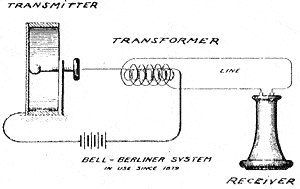
The Mechanical Reproduction of Sound
Bell and Edison nonetheless went ahead to capitalize on Berliner’s inventions. Berliner went back to Germany in 1881 and with his brother Joseph founded the Telephon-Fabrik Berliner. In 1883, Jacob Berliner, another brother, joined the firm as partner and business director. Branches were thereafter established in Vienna, Berlin, Budapest, London, and Paris.16
During that same period, many inventors were also working on the mechanical reproduction of sound. The first such device was created by Leon Scott as early as 1855. Scott incised a sound-actuated spiral groove on a revolving cylinder. He called his mechanism a phonautograph; it was sold in 1859 for scientific sound analysis purposes.
Just as Bell had duplicated the work of Reis and Meucci, and thereafter appropriated Berliner’s inventions, so Thomas Edison had an instrument built duplicating the pioneering work of Scott et al. Edison renamed the device the "tinfoil phonograph," after the medium used to register the sound waves. Albeit he was not the inventor, Edison was savvy enough to patent the device in 1878, and first used it for recording his famous recitation of "Mary had a Little Lamb." He founded the Edison Speaking Phonograph Company in that same year and marketed the instrument.
Having cashed in on the highly successful "Bell-Berliner" telephone, Bell Laboratories entered the competition for mechanical sound reproduction. Bell assigned his cousin Chichester A. Bell and Charles Sumner Tainter to improve on the instrument, and they produced a model in 1881. Bell offered the improvements to Edison and was rebuffed. The two mechanisms, in fact, employed similar principles.
In 1887 Bell’s instrument was marketed as a graphophone. It had two advantages over Edison’s cruder device: It used a spring mechanism and therefore did not have to be cranked by hand as it recorded or played back; It used a wax cylinder as opposed to cardboard and tin foil. Instead of a "tinny’ sound and a two minute limit, a slightly better reproduction and longer duration resulted.
"Edison ‘knocked off’ the graphophone and introduced his own improved phonograph. Bell and Tainter in turn stole an Edison innovation, Both firms vied for leadership in a non-existent market for office sound-recording devices."17
More lawsuits ensued. Ironically, however,
as Stefan Jones noted above, neither the Edison phonautograph nor
the Bell graphophone had significant commercial potential. The
attempt to interest business men to employ the instruments as dictating
machines proved a dismal failure. Nor were they able to produce a reasonably
accurate reproduction of music. Both instruments would likely have disappeared
had not an investor, J. H. Lippincott, bought out both firms, and sold
the devices to drug stores, where they were used as jukebox curiosities.
After Lippincott was struck with paralysis, Edison bought the virtually
moribund "Columbia Phonograph Company" in 1890.
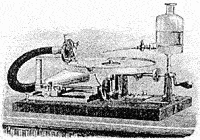
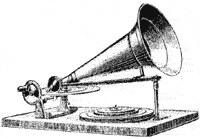
The Invention of the Gram-o-phone
Berliner returned from Germany to Washington in 1883, where he resumed his independent research on mechanically recording sound. Unlike Bell and Edison, Berliner did not deign to imitate the devices extant at the time. He had likewise been aware of the principles of the instruments invented by a Frenchman, Charles Bouseouil who first conceived the idea of sending speech by telegraph; by another Frenchman, Leon Scott, who invented the phonautograph, which could only register sound on a carbon-covered cylinder; and the research written on the subject by a third French pioneer in the field, Charles Cros, entitled: "A Process of Recording and Reproducing Audible Phenomena.."
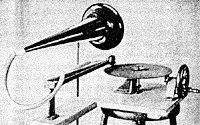
The genius Berliner had exhibited in making the telephone a viable instrument with enormous commercial potential now came to the fore. Berliner resolved the defects of the extant systems by going on to invent new recording materials, a new principle of recording, and a new instrument to play back the recorded sounds.
Believing that a flat surface could more be more accurately cut and impressed than a cylinder, Berliner turned to recording on flat discs. He sought more durable materials on which to record, experimenting with celluloid, hardened rubber, then with zinc and other metals. The sound impressions were made by cutting through a wax coating on the metal, after which the discs were immersed into an acid bath. Eventually he developed a hardened shellac disc, which proved to be a superior material. Shellac discs gave mechanically-reproduced sound vast commercial possibilities, for they could be duplicated cheaply and in great quantities by impressing them on a master disc.
Berliner also devised a way to incise sound impressions laterally ("side-to-side"), rather than vertically ("hill and dale"), so that, inasmuch as the side of a needle was employed rather than its point, wear was much reduced.
"Emile Berliner took human sound, whether uttered in speech or song, and reproduced it, not as a parody as in the tinfoil phonograph, or in the wax-cylinder graphophone... but in accurate and fadeless form, to echo down the ages as long as time endures. He enabled mankind to ‘hold communion with immortality.’"18
Berliner then engineered a disc-playing machine which he called a Gramophon. He cut off a telephone transmitter (in effect, his microphone) affixed a metal stylus to the diaphragm, and moved it along the spiral groove etched into the recording. Both the rendition and the amplification of sound thus achieved a degree of perfection previously unattainable. The Berliner innovations have endured to the present day and are integral to every record-player. In 1887, Berliner patented his entirely original discoveries and mechanisms in the United States and in Germany. He and some friends founded the United States Gramophone Company in 1893. In 1897 he founded the Berliner Gram-o-phone Company in Montreal.
"The Berliner Gram-o-phone Company was the first record company in Canada and the first to manufacture records and "talking machines." The first records produced in Canada, seven-inch single-sided discs, were issued on January 2, 1900. Ten-inch records followed in 1901 and 12 inch discs in 1903. The first double-sided records were manufactured in 1908."19
In 1898, Berliner also founded the Deutsche Gramaphon Gesellshaft and Britain’s Gramophone Co. Ltd. to market his instruments and records in Europe.
"The history of recorded music in India began not long after the invention of the gramophone by the American, Emile Berliner in 1888. One of the Berliner associates set up the Gramophone company in England in 1898. Three years later, the recording company opened a branch in Calcutta, initiating a golden era of 78RPM gramophone music which lasted until the early 70's... Its original label, depicting an angel writing on a disc, was later replaced by the dog listening to a gramophone."
"So complete was the Gramophone’s monopoly over the 78 RPM record business that its Dum Dum factory was the only in India until the German Polydor Company set up its unit in Bombay."20
On the 16th of May, 1888, Berliner presented his gramophone to the public at the Franklin Institute in Philadelphia. In his lecture he invited the members of the Institute to "accompany him on a prophetic tour into the future:"
"Future generations will be able to condense within the space of twenty minutes a tone picture of a single life time. Five minutes of a child’s prattle, five of the boy’s exultation, five of the man’s reflections, and five from the feeble utterances from the death-bed. Will it not like holding communion with immortality?"
In 1890 the Scientific American published a review of Berliner’s discoveries with illustrations of Berliner’s apparatus for recording sound and of the gramophone, crediting Berliner with their invention.
"In 1901Edison introduced "Gold Mold" cylinders with an improved hard wax surface and able to be mass-produced by molding process." The process did not endure.
In that same year, 1901, Emile Berliner (United States Gramophone Company) engaged the Victor Company, headed by Eldridge R. Johnson, to produce his gram-o-phone. It was marketed as the "Victrola." The Victor Co. "Released ‘Red Seal’ discs with 4-minute capacity for $1.00 each, featuring famous European artists, such as tenor Enrico Caruso and baritone Mattia Battistini."21 They set the standard for the industry. Berliner records are the prized possessions of the world’s record collectors.
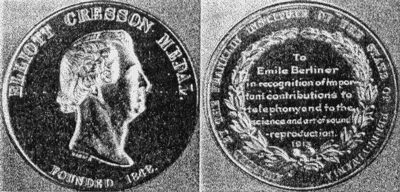
Nipper and "His Master’s Voice"
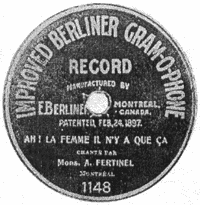
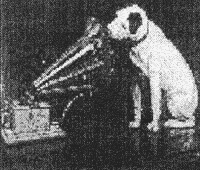
Nipper the dog was born in Bristol in 1884 and so named because of his tendency to nip the backs of visitors legs. Nipper was "a mutt, part bull terrier with a trace of fox terrier."22 The brother of Nipper’s master, the artist Francis Barraud, painted Nipper listening to a phonograph, and registered it on February 11, 1899 as "Dog looking at and listening to a Phonograph." Barraud tried to sell the painting to the Edison Bell Company without success. "‘Dogs don’t listen to phonographs,’ the company said."
In an article for the Strand Magazine, Barraud wrote that he next visited the English Gramophon Company Ltd., whose manager, Barry Owen offered to buy the painting if the cylinder-playing device in the painting could be repainted with a disc-playing machine. Barraud was paid £100 for the painting and copyright. In January, 1900, the painting made its public appearance on the Gramophone Company’s advertisements. Nipper listening to a gramophone was registered as the company’s trademark on July 16, 1900. Nippur first appeared on the back of a recording of Frank Bata singing "Hello my Baby." In 1901 more than two million records were sold by The Gramophone Company. In 1908 recordings began to be made on both sides of the discs.22
"Francis Barraud spent much of the rest of his working life painting 24 replicas of his original, as commissioned by The Gramophone Company." In 1907, the illustration was captioned "His Master’s Voice," and it was so registered as a trademark in 1910.23
Treason
Emile Berliner remained trusting of Americans despite his encounters with Bell, Edison and other rapacious American businessmen. Consequently, his bitter experiences in the U.S. A were not yet over.
"In the fall of 1895 a group of businessmen invested $25,000 in the Berliner Gramophone Company, and its headquarters were installed in Philadelphia. Berliner became a minor stockholder in the company. Frank Seaman of New York was contracted to publicize the product."
"Thus Emile Berliner’s invention was now in the hands of three companies: The Berliner Company of Philadelphia, which manufactured the gramophones and the records, the Seaman’s National Gramophone of New York which was charged with publicity, and the United States Gramophone Company of Washington which controlled patent rights. At the end of 1900, Seaman’s National Gramophone concluded an agreement with American Graphophone and with Columbia Phonograph for the manufacture of the Zonophone. Emile Berliner viewed establishing agreements with companies associated with Bell, Edison and Western Union as a treacherous abrogation of its exclusive sales rights."
Berliner’s contracts with his associates, however, were too loosely drawn, and his minority position allowed "Seaman to launch an injunction against the Berliner Gramophone Company on June 25, 1900, obliging Emile Berliner to cease the sales of his gramophone throughout the United States. These problems were without doubt the reasons that Emile Berliner decided to establish his company in Montréal. His young grandson, Oliver Berliner, explained in a 1992 issue of Antique Phonograph News, that he chose Montréal because railroad transportation was easy between Montréal and Philadelphia."
"...In 1924 the Victor Talking Machine bought the company, and was absorbed in 1929 into the RCA to become RCA Victor."24 The "His Master’s Voice" trademark was inherited by each succeeding company and became one of the world’s most recognized trademarks.
Emile Berliner’s research and inventions in the field of acoustics were not confined to the telephone and record-player. He found time to determine why antique violins were more brilliant than newly-produced instruments and to resolve the problems of acoustics in concert halls and other spaces.
Nor was acoustics the only discipline to which Berliner made major contributions. He was also involved in aviation and public health. He contributed seminal work on the helicopter and fixed-wing aircraft; He was responsible for saving the lives of hundreds of thousands of American children.
Those facts about the unheralded technological genius, Emile Berliner, as well as his entry into the arts as a composer are covered in HHF Fact paper 27-II.
Notes
Note: Inasmuch as the biography, Emile Berliner, Maker of the Microphone by F. W. Wile, Bobbs Merrill Company, 1926, is the only substantial work extant on the subject, many facts were culled from it, and are not always footnoted. Quotes that are not footnoted are taken from his book.
Much credit and thanks is due to Sam Berliner III, who did a thorough search for sources and information on Emil Berliner, albeit he disclaims any relationship to the inventor. Sam Berliner was generous in supplying information and leads to other sources on his web site, http://home.att.net/-Berliner-Ultrasonics/berlemil.html.
- Museum Phonographen Grammophone: "Wie so oft in der Zeit der industriellen Abenteuer gegen ende des 19. Jahrhuderts stand am Anfang der Name eines Mannes: Emile Berliner. Http://www.Phonograph.com/deutsch/bio_berl.htm
- Das Museum Phonographen Grammophone: http://www.phonograph.com/deutsch/bio-berl.htm.
- Wile, Emile Berliner, Maker of the Microphone, Bobbs Merrill Company in 1926, 11.
- Wile, Ibid, 35.
- Encyclopedia Britannica, "Telephone," 1911.
- Sylvanus P. Thompson, B.A., D. Sc., Philip Reis; Inventor of the Telephone, London, 1883, 6.
- Giovanni E. Skive, Antonio Meucci, Inventor of the Telephone, The Vigo Press, NY, 1958, p. 9.
- Skive, Ibid, 16 .
- Wile, Ibid, 83.
- Wile Ibid., 96.
- Enc. Britannica, Idem.
- Wile, Ibid, 99-100.
- Wile, Ibid, 115,
- Wile Ibid, 127-8.
- Wile, idem.
- Internet: S. Berliner, III’s Hannover Berliners Page, quoting from a translation from the Catalog of an Exposition of the Historical Museum in Hanover by Peter Shultz, The Berliners - a Jewish Family in Hanover (1773-1943). Http://home.att.net/~Berliner-Ultrasonics/berlhann.html .
- Internet, Stefan Jones, SeJ@aol.com, who took his facts from Roland Galled, The Fabulous Phonograph, J. B. Lippincott, NY, 1955.
- Wile, Ibid., 169.
- National Library of Canada, Internet: http://www.nlc-bnc.ca/services/eberlinr.htm.
- Goal Kondagunta, Internet:"78 RPM Records History," gkondagu@top.magnus.acs.ohio-state.edu.
- Steven Schoenherr, "Recording Technology History," http://www.mcmix.com/html/rectechis.htm.
- "The Nipper Saga," http://www.ais.org/~Isa.
- Http://www.ebs.hw.ac.uk/EDC/CAC/m100/nipper.html.
- Musée des
Ondes Berliner, Montréal, Canada, "La Berliner Gramophone:
http://www.contact.net/berliner/biogrfr.html.
